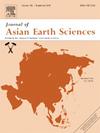Late pleistocene erosion rates of Gushan mountain, Southern Shanxi Rift, North China: evidence from cosmogenic 10Be and 26Al
IF 2.7
3区 地球科学
Q2 GEOSCIENCES, MULTIDISCIPLINARY
引用次数: 0
Abstract
Erosion serves as a critical link connecting various geological factors that shape landforms, making the quantitative studies of erosion rates of great significance for understanding landscape evolution. In this paper, we first quantified the bedrock erosion rates of the Gushan Mountain in the southern Shanxi Rift, using in-situ produced cosmogenic 10Be and 26Al. The results show that the minimum exposure ages range from 115.4 ± 7.2 ka to 26.5 ± 1.7 ka, with erosion rates varying between 5.2 ± 0.3 mm/ka and 23.6 ± 1.5 mm/ka. Ridge samples exhibit erosion rates approximately twice as high as summit samples, suggesting spatial variability in erosion processes and significant influences of topygraphy. The erosion rates of the Gushan Mountain are significantly lower than the basin erosion rates in the Taihang Mountains, suggesting landscape disequilibrium. These rates are comparable to denudation rates derived from low-temperature thermochronology, pointing to a long-term slow-paced landscape evolution of the Gushan Mountain. However, they are significantly lower than denudation rates in adjacent mountains (e.g., Taihang and Zhongtiao Mountains), highlighting the dominant role of tectonic activities in controlling erosion. The differential tectonic activities between the E’mei Platform (hosting Gushan Mountain) and the surrounding mountains of the Shanxi Rift has contributed to observed spatial variation in erosion rates. Notably, the uplift of the E’mei Platform during the Late Pleistocene had a negligible impact on the erosion of the Gushan Mountain.
山西裂谷南部古山晚更新世侵蚀速率:来自宇宙成因10Be和26Al的证据
侵蚀是连接形成地貌的各种地质因素的关键环节,对侵蚀速率的定量研究对于理解景观演化具有重要意义。本文首先利用原位产的宇宙成因10Be和26Al,量化了晋南裂谷谷山的基岩侵蚀速率。结果表明:最小暴露年龄为115.4±7.2 ka ~ 26.5±1.7 ka,侵蚀速率为5.2±0.3 ~ 23.6±1.5 mm/ka;山脊样品的侵蚀速率大约是峰顶样品的两倍,这表明侵蚀过程的空间变异性和地形的显著影响。古山的侵蚀速率明显低于太行山的盆地侵蚀速率,表明景观不平衡。这些速率与低温热年代学得出的剥蚀速率相当,表明孤山的景观演化长期缓慢。但明显低于相邻山脉(太行山、中条山)的剥蚀速率,说明构造活动在控制侵蚀中起主导作用。峨嵋地台(姑山所在地)与山西裂谷周边山脉的不同构造活动导致了观测到的侵蚀速率空间差异。值得注意的是,晚更新世峨眉台地隆升对孤山侵蚀的影响可以忽略。
本文章由计算机程序翻译,如有差异,请以英文原文为准。
求助全文
约1分钟内获得全文
求助全文
来源期刊

Journal of Asian Earth Sciences
地学-地球科学综合
CiteScore
5.90
自引率
10.00%
发文量
324
审稿时长
71 days
期刊介绍:
Journal of Asian Earth Sciences has an open access mirror journal Journal of Asian Earth Sciences: X, sharing the same aims and scope, editorial team, submission system and rigorous peer review.
The Journal of Asian Earth Sciences is an international interdisciplinary journal devoted to all aspects of research related to the solid Earth Sciences of Asia. The Journal publishes high quality, peer-reviewed scientific papers on the regional geology, tectonics, geochemistry and geophysics of Asia. It will be devoted primarily to research papers but short communications relating to new developments of broad interest, reviews and book reviews will also be included. Papers must have international appeal and should present work of more than local significance.
The scope includes deep processes of the Asian continent and its adjacent oceans; seismology and earthquakes; orogeny, magmatism, metamorphism and volcanism; growth, deformation and destruction of the Asian crust; crust-mantle interaction; evolution of life (early life, biostratigraphy, biogeography and mass-extinction); fluids, fluxes and reservoirs of mineral and energy resources; surface processes (weathering, erosion, transport and deposition of sediments) and resulting geomorphology; and the response of the Earth to global climate change as viewed within the Asian continent and surrounding oceans.
 求助内容:
求助内容: 应助结果提醒方式:
应助结果提醒方式:


